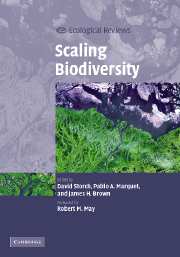Book contents
- Frontmatter
- Contents
- List of contributors
- Foreword by Robert M. May (Lord May of Oxford)
- Preface
- 1 Introduction: scaling biodiversity – what is the problem?
- PART I Spatial scaling of species richness and distribution
- 2 Species–area curves and the geometry of nature
- 3 The distribution of species: occupancy, scale, and rarity
- 4 Species distribution patterns, diversity scaling and testing for fractals in southern African birds
- 5 Geometry of species distributions: random clustering and scale invariance
- 6 Toward a mechanistic basis for a unified theory of spatial structure in ecological communities at multiple spatial scales
- PART II Alternative measures of biodiversity: taxonomy, phylogeny, and turnover
- PART III Scaling of biological diversity with energy and the latitudinal biodiversity gradient
- PART IV Processes, perspectives, and syntheses
- Index
- Plate section
- References
3 - The distribution of species: occupancy, scale, and rarity
Published online by Cambridge University Press: 05 August 2012
- Frontmatter
- Contents
- List of contributors
- Foreword by Robert M. May (Lord May of Oxford)
- Preface
- 1 Introduction: scaling biodiversity – what is the problem?
- PART I Spatial scaling of species richness and distribution
- 2 Species–area curves and the geometry of nature
- 3 The distribution of species: occupancy, scale, and rarity
- 4 Species distribution patterns, diversity scaling and testing for fractals in southern African birds
- 5 Geometry of species distributions: random clustering and scale invariance
- 6 Toward a mechanistic basis for a unified theory of spatial structure in ecological communities at multiple spatial scales
- PART II Alternative measures of biodiversity: taxonomy, phylogeny, and turnover
- PART III Scaling of biological diversity with energy and the latitudinal biodiversity gradient
- PART IV Processes, perspectives, and syntheses
- Index
- Plate section
- References
Summary
Introduction
Species occupancy is typically measured as the number of cells occupied by the species in a study area. Because it is easy to document and interpret and it correlates with species abundance, occupancy is widely used for measuring species rarity and for assessing extinction risk on which conservation decisions are made (Gaston, 1994; Fagan et al., 2002; Hartley & Kunin, 2003; Wilson et al., 2004). Ecologists and conservation practitioners, however, have long realized that occupancy often fails to capture significant spatial features of distribution. It is possible that two species having the same occupancy can exhibit very different patterns (Fig. 3.1). Most species in nature are discretely distributed due to the patchiness of landscapes, or due to intrinsic reproductive or dispersal behavior of the species. An outstanding problem concerning species distribution in space is how to describe the patchiness of a species and to measure the effect of changing spatial scale (cell size) on the patchiness for the purpose of predicting distribution at fine scales from coarse scales.
There are two primary approaches to addressing this question. The first one is to use existing measures and methods to describe patchiness and scale effect. Many fragmentation indices in landscape ecology can be used for this purpose (Turner, Gardner & O'Neill, 2001; Wu et al., 2003). These include edge length (perimeter), the number of patches, perimeter/area ratio and many other indices to capture the spatial features of species distribution.
- Type
- Chapter
- Information
- Scaling Biodiversity , pp. 32 - 50Publisher: Cambridge University PressPrint publication year: 2007
References
- 30
- Cited by



